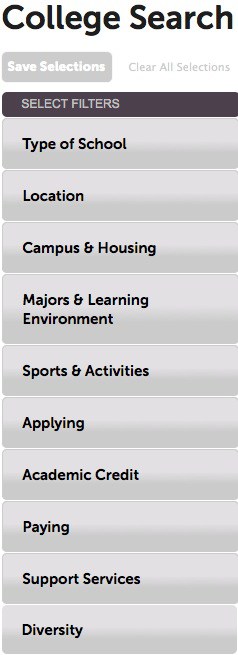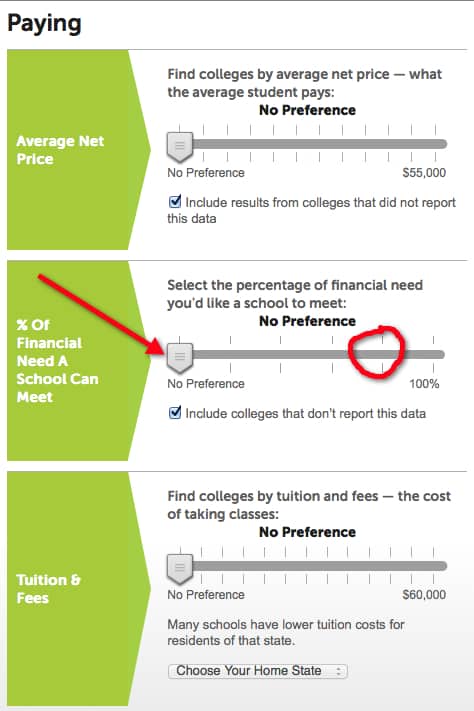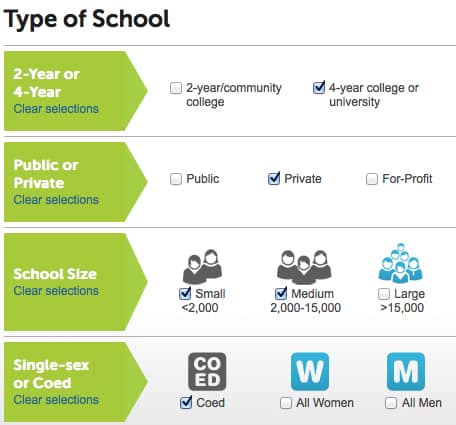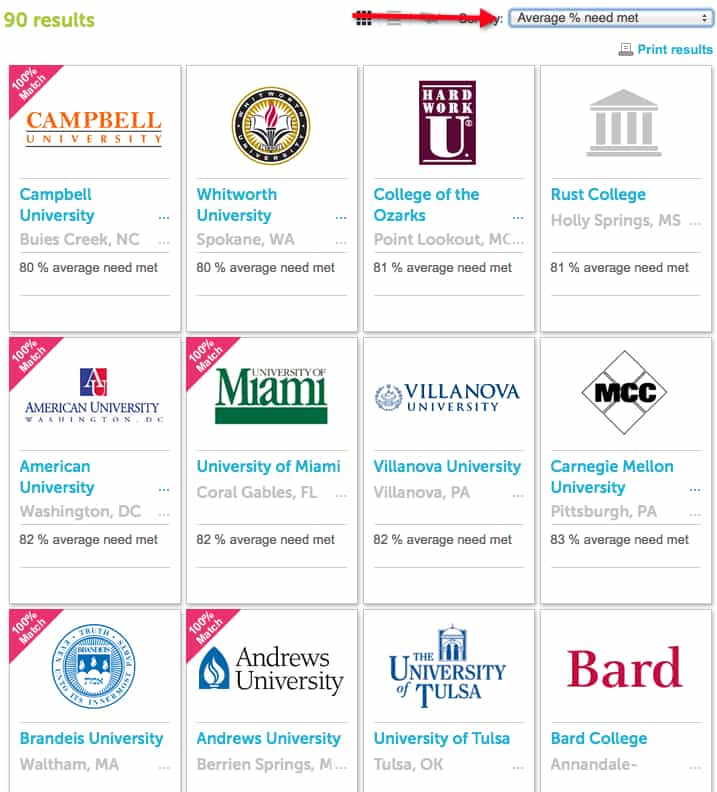How do you find colleges with the best financial aid?
One way to simplify your search for colleges is to look for the institutions that typically meet the highest percentage of financial need. Of course, the best scenario is for your child to get accepted into a school that meets 100% of all its students’ demonstrated financial needs. Here’s an example:
Let’s say a student has an expected family contribution of $20,000 and the school that accepts him costs $55,000. The institution would offer the applicant a $35,000 financial aid package. The schools with the very best aid — all elite institutions – don’t include any loans in their packages.
The vast majority of schools, however, will not provide 100% aid packages, but there is a wide variety of generosity among institutions. Wouldn’t it be nice if you could sort schools by this financial aid factor?
Actually, you now can thanks to the College Board’s search engine which allows you to search for schools based on net price and by percentage of financial need met.
Searching by Financial Need Met
I’m going to demonstrate how you can use the percentage-of-need met criteria to find the most generous schools.
Step No. One:
Head to College Board’s home page and click on the blue College Search term on the left-hand side.
Step No. 2:
You’ll be taken to the College Board’s line up of 10 major search categories.
Step No. 3:
To get started, I clicked on the Paying tab and was directed to the page below. I think the most valuable search criteria in this section is the % of Financial Need A School Can Meet. You can use the sliding bar to select the percentage that is offered in 20 percentage-point increments. For purposes of this illustration I’m going to use 80%.
Step No. 4:
You don’t want to search exclusively for schools with this criteria because the universe will be too large. You would get private for-profit and non-profit and public schools and two and four-year institutions. You can narrow this unwielding list by using additional criteria. For this example, I clicked on the Applying link which is among the 10 main categories. As you can see below, I stipulated that I wanted schools that are very selective and most selective and I also typed in some SAT and ACT scores.
Step No. 5:
Next I headed to the Type of Schools category. I requested four-year, private institutions with no more than 15,000 students.
Step No. 6:
I next selected the Campus and Housing category and made the following selections:
 Step No. 7:
Step No. 7:
You can keep adding criteria when using the College Board’s search engine, but I’m stopping here. In the upper right hand corner of whatever search criteria you use, you’ll see the following instruction:
Click on that X and you’ll get your list of matches in alphabetical order. Here are the first ones in a group of 90 hits that I generated:
Step No. 8:
You are almost done!
You still need to sort your list by percentage of need met. Remember that I requested a list of schools that meet at least 80% of financial need. I want to see all schools that are in the 80%-to-100% range. To do this I used the drop-down menu and designated that I’d like schools sorted by Average % need met. Below you can see the beginning of the list of 90 schools that ends with the institutions that meet 100% of need.
Step No. 9:
You need to keep in mind that the figures that the College Board display come from the schools themselves. I would regard the figures from some schools quite skeptically. Take, for example, Andrews University. While the school says it meets 85% of need (it’s cut off on my screenshot), when I looked at its financial aid figures at the College Board, only 52% of the university’s average aid package is grants/scholarships. I don’t consider that a generous school. Take a close look at the financial statistics that you can find for any institution on the College Board.
Andrews University
 Bottom Line:
Bottom Line:
Even with this tool, you’re going to need to do your homework, but it can be a great way to narrow your list of realistic college choices.







Wonderful tool! Will use for sure with my current juniors/rising seniors..
Thanks Luz! I’m glad you like the post. And thanks for taking my online class!
Lynn O’Shaughnessy
I wish I had known about this method earlier, during my college application process. Anyway, please check out this small complimentary article on ParentsandColleges.com also on Top 10 Financial Aid Providers’:
http://www.parentsandcolleges.com/top-ten-lists/list01-fap/
Yeah, if one’s EFC equals the COA (which I suspect is the case with the majority here) this information is less than useless.
How does a school’s net price calculator indicate merit based aid?
Hi Leah,
The schools that use a federal template don’t include merit aid. These calculators only ask a few questions. More elite, prestigious schools tend to use merit aid calculations. These calculators are going to ask about GPA, test scores etc. For these schools, the net price will take into account any merit award.
Lynn O’Shaughnessy
I tried out the tool and it is very helpful. If my expected EFC is the same or greater than the COA then how does one use this tool?
Hi Vinod,
If your EFC is the same as a school’s cost of attendance then you are going to look for institutions that award merit scholarships to affluent students. Most colleges do. This tool won’t help in this case. You will want to use the net price calculator of schools on your child’s list to determine if you will be getting a price break via a merit award.
Lynn O’Shaughnessy
Great tool! I will recommend to my friends and clients.
Great tool! I’ll have to try it for next kid.